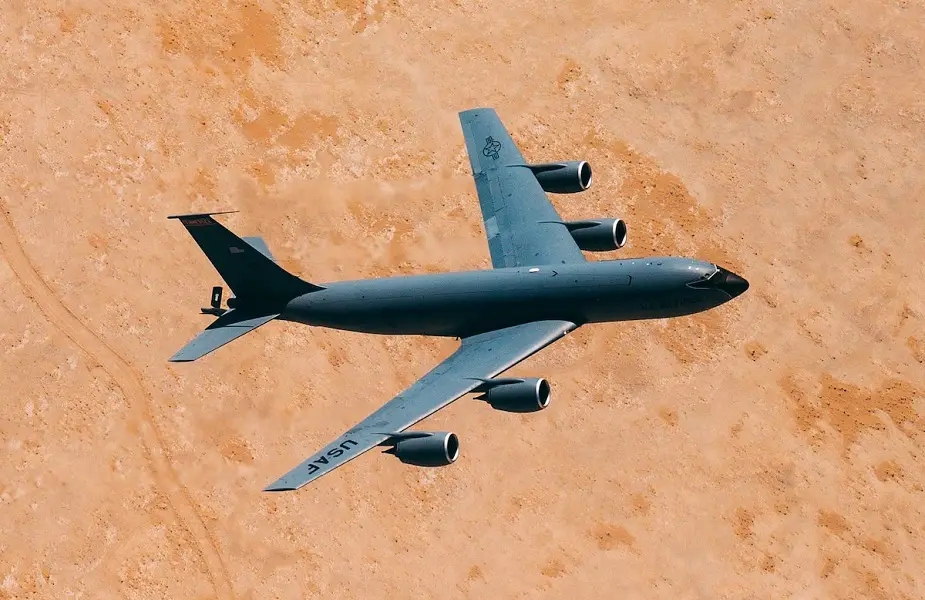Breaking news
US Air Force partners with Twelve to convert CO2 into operationally viable aviation fuel.
What if you could access fuel from anywhere on the planet, at any time, no tanker required? The US Air Force thinks it’s possible with ground-breaking carbon transformation technology. Separate from carbon capture and storage or carbon utilization, carbon transformation can turn carbon dioxide from the air into nearly any chemical, material, or fuel, including jet fuel.
Follow Air Recognition on Google News at this link

A U.S. Air Force KC-135 Stratotanker, assigned to the 350th Expeditionary Aircraft Refueling Squadron, flies over Qatar, Feb. 13, 2021. Through an innovative project, the Air Force is attempting to create new fuel options aircraft use including carbon transformation that can turn carbon dioxide from the air into nearly any chemical, material, or fuel, including jet fuel (Picture source: US Air Force)
In 2020, Air Force Operational Energy endorsed the carbon transformation company, Twelve, to launch a pilot program to demonstrate that their proprietary technology could convert CO2 into operationally viable aviation fuel called E-Jet.
The project hit a major milestone in August of this year when Twelve successfully produced jet fuel from CO2, proving the process worked and setting up the conditions to create the synthetic carbon-neutral fuel in larger quantities. The first phase of the project is scheduled to conclude in December with a report detailing the process and findings.
For the Air Force, the implications of this innovation could be profound. Initial testing shows that the system is highly deployable and scalable, enabling the warfighter to access synthetic fuel from anywhere in the world. Reliable access to energy and fuel is paramount to military operations. Recent joint wargaming and operational exercises have underlined the significant risk that transporting, storing, and delivering fuel poses to troops – both at home and abroad.
At the height of the war in Afghanistan, attacks on fuel and water convoys accounted for more than 30% of casualties. Yet, fuel demand is only expected to increase as advanced weapon systems and operations require increasing levels of power.
“History has taught us that our logistics supply chains are one of the first things the enemy attacks. As peer-adversaries pose more and more of a threat, what we do to reduce our fuel and logistics demand will be critical to avoid risk and win any potential war,” said Roberto Guerrero, deputy assistant secretary of the Air Force for operational energy.
Currently, the Department of the Air Force relies on commercial fuel to operate, both domestically and abroad. The Air Force must use a combination of trucks, aircraft, and ships to ensure fuel is delivered to meet warfighter demand. However, many areas of operation cannot always easily reach traditional access points of the supply chain, particularly during conflict.
Twelve’s carbon transformation platform could allow deployed units to create fuel on demand, without the need for highly skilled fuel experts on site. The Air Force sees the opportunity for the technology to provide a supplemental source to petroleum-based fuels to decrease demand in areas that are typically difficult to deliver fuel to.
“With carbon transformation, we are untethering aviation from petroleum supply chains. The Air Force has been a strong partner in our work to advance innovative new sources of aviation fuel,” said Nicholas Flanders, Twelve co-founder and CEO.
Most synthetic fuels, which are created by a mix of carbon monoxide and hydrogen known as syngas, are produced through burning biomass, coal, or natural gas. Twelve’s technology eliminates the need for fossil fuels, producing syngas by recycling CO2 captured from the air and – using only water and renewable power as inputs – transforming the CO2.
The process of converting syngas into liquid hydrocarbon fuels is not new. Known as Fischer-Tropsch synthesis, the multistep method was created in the 1920s by German scientists and aided the German war effort during World War II.
Today, it is widely used to produce liquid fuels for transportation. Fischer-Tropsch certified synthetic fuels are approved as a ‘drop-in’ fuel for each specific aircraft, first commercially, and then by the U.S. military and the aircraft’s associated system program office. The highest blend currently certified is a 50/50 blend of FT synthetic fuel and petroleum fuel. Twelve’s system produced FT-Synthetic Paraffinic Kerosene, which can be blended with petroleum – up to a maximum blend of 50%.
Once the first phase of the program concludes at the end of 2021, the Air Force Operational Energy office will look to the next phase of scaling the technology to produce synthetic fuel in larger quantities. If brought to scale, the platform would enable more agile operations and decrease dependence on foreign oil, while having the added benefit of mitigating carbon emissions – a Department of Defense key priority under Secretary of Defense Lloyd Austin III.
While there remain a number of unanswered questions to make this technology operational, such as how to power the production of the syngas in remote areas and where water sources for the necessary hydrogen will come from (Twelve notes that water for the process can also be captured from the air), the team sees this is a positive first step in a truly innovative program.
“My office is looking at a number of initiatives to not only optimize aviation fuel use for improved combat capability, but to reduce the logistics burden as well,” Guerrero said. “We’re excited about the potential of carbon transformation to support this effort and Twelve’s technology – as one of the tools in our toolbox – could help us get there.”

























